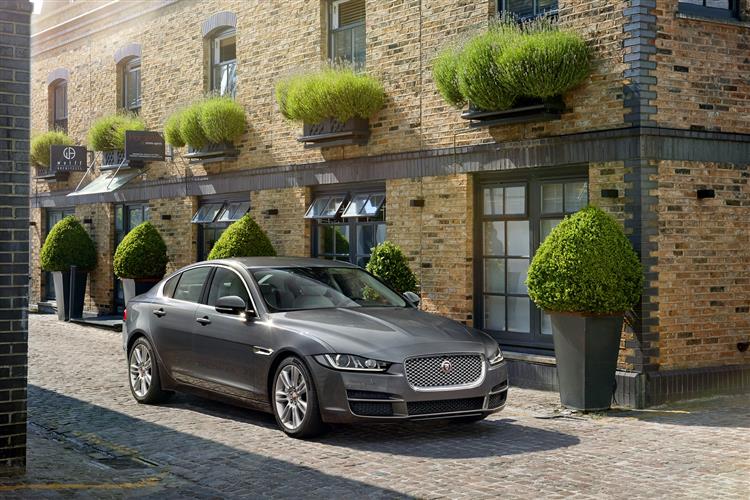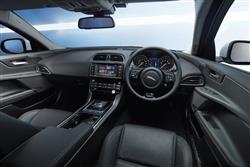COMPACT CLASS (some text hidden) --NONE--
By Jonathan Crouch
Introductionword count: 80
The Jaguar XE delivers a smartly executed take on the compact executive genre, offering something appealingly different to the usual German suspects. On paper at least, it seems to have the design, technology and ambition necessary to appeal in this segment, with the dynamics of a BMW and the luxury of a Mercedes, plus all the efficiency and connectivity modern business buyers now expect. Here, we look at the original 2015-2018-era versions of this model from the used buyer's perspective.
Modelsword count: 14
4dr Compact Executive Saloon (2.0 petrol / 3.0 V6 supercharged petrol / 2.0d diesel)
Historyword count: 288
At its launch in 2015, the XE turned out to be the most advanced, efficient and refined sports saloon the Jaguar brand had ever built, a compact executive model that at last, offered a credible alternative to premium models in the 3 Series, C-Class or A4 segment. From launch, the car featured frugal Ingenium engines and had a 'clean sheet' feel to its design underpinned by the £2 billion-worth of investment that had been poured into it. Everything, in other words, was very different to what we were given the last time Jaguar entered this segment back in 2001 with the ill-fated X-TYPE. That car showed this Coventry marque the hard way that there are no short cuts to success in the compact executive sector, something brands as significant as Toyota have also learnt to their cost. The Japanese maker tried for years to create a Lexus IS by simply reworking an Avensis and Jaguar's experience in trying to fashion that X-TYPE out of a humbler Ford Mondeo was just the same. Forget all that though, for this is a very different car, a proper Jaguar and a proper challenger to the Germans in this class that arrived with a very clear objective: to return its brand to the forefront of this sector, the position it enjoyed with the iconic MK II model back in the Sixties. That's a lot to ask, which is why the brand took so long to re-enter this crucial segment. Expectations are high for the XE, but sales were relatively disappointing, with only around 40,000 sales in its first four years of production life. The car was significantly updated in the Spring of 2019, but it's the earlier versions we look at here.
What You Getword count: 488
As its predecessor the MKII model was in the Sixties, this XE is unmistakeably a Jaguar, its upscale proportions delivering the kind of dynamic and purposeful look needed for success in this segment. It's unmistakeably a modern Jaguar too, so there are few of the retro touches that have so characterised and maturely pigeonholed some of the brand's other modern era designs like the S-TYPE and the X-TYPE. Instead, the XE echoes the styling approach first established by its larger XF showroom stablemate, with an aggressive grille, a strongly-sculpted bonnet, a steeply raked windscreen and a rising waistline. The resulting shape catches the eye - and cleaves the air like no Jaguar before it, registering a phenomenally low 0.26 drag coefficient. It's not afraid to be different either, not only in how it looks but also in how it's made. At launch, this was the lightest and stiffest car the brand had ever built, thanks to the fact that over 75% of its structure is fashioned from aluminium, a proportion far higher than you'll find in any other rival in this class from this era. At the wheel, you sit low, cocooned by a deep centre console that creates a cockpit-style feel. There isn't perhaps the really high-end premium feel that you'd get in a better-appointed Mercedes C-Class, but in upper-spec models, buyers can get themselves a cabin easily on a par with that of a rival BMW 3 Series and Audi A4. There are interesting touches too, like the smart metal-finished air vents that extend the fascia to nestle into the door casings - and of course Jaguar's trademark rotary automatic gear shifter that glides up into the palm of your hand on start-up. The dished three-spoke leather-stitched wheel is also distinctive, if slightly over-buttoned, with cruise control functions fitted on one side and switches for driving information adjustments on the other. Through it, you view an instrument binnacle dominated by a rather low-res driving information display and pair of deeply-cowled dials that Jaguar would prefer you recognised from their F-TYPE sportscar rather than a Range Rover Evoque. Also attempting to deliver cabin clarity is the feature that dominates the centre console, the colour touchscreen that lies at the heart of the XE's 'InControl' infotainment system. It not only deals with the expected audio, climate, telephone and navigation functions but also allows access to a whole suite of 'InControl' connected-car technologies. As for the rear seat, well initially, the high rear deck makes it appear to be a little claustrophobic but get yourself comfortable and you'll find that it's a little more spacious than it first appears. Even if you're a six-footer sitting behind a front occupant of similar stature, you should still have an inch or so of legroom to spare, thanks in part to the deeply-scalloped seatbacks. The boot, at 455-litres in size, is 25-litres smaller than that provided by rival BMW and Mercedes models.
To see the full road test text contact us on 0330 0020 227
Pictures (high res disabled)

.jpg)
|
.jpg)
|
.jpg)
| |||
.jpg)
|
.jpg)
|
.jpg)
| |||
.jpg)
|
.jpg)
|

|
Scoring (subset of scores)
Category: Luxury Saloons and Estates
| Performance | |
| Handling | |
| Comfort | |
| Space | |
| Styling, Build, Value, Equipment, Depreciation, Handling, Insurance and Total scores are available with our full data feed. | |



